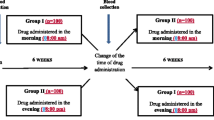Summary
The efficacy and safety of the HMG CoA reductase inhibitor fluvastatin have been evaluated in a double blind study in 52 patients with familial hypercholesterolaemia. A standard AHA Phase II lipid lowering diet was prescribed throughout the study. After 6 weeks of a single blind dosage stabilisation period, in which patients received fluvastatin 40 mg qPM, patients were randomly allocated to one of two double blind treatment groups: group A (n=24) received fluvastatin 20 mg b. d. for 12 weeks and fluvastatin 20 mg AM + 40 mg PM for an additional 12 weeks; Group B (n=28) received fluvastatin 40 mg qPM during the entire study. Safety and tolerability were evaluated by the analysis of biochemical and haematological parameters, and ophthalmological and physical examinations. Efficacy was analysed by the determination of plasma lipids, lipoproteins and apoproteins.
Fluvastatin 40 mg/d was associated with up to a 27.4% decrease in LDL-C and a 9.6% increase in HDL-C concentrations. Increasing the dose of fluvastatin from 20 mg b. d. to 60 mg per day in Group A was associated with a 7.1% decrease in LDL-C, a 12.1% increase of HDL-C and a 12.8% decrease in the LDL-C/HDL-C ratio. In comparison with Group B (40 mg qPM) LDL-C, HDL-C and the LDL-C/HDL-C ratio in Group A (60 mg) differed by −8.9%, 6.6% and −12%, respectively. During treatment with 40 mg qPM, one patient developed an asymptomatic but notable elevation of CK to 1823 U/l (normal range 0–100 U/l) that was caused by strenuous exercise. No other notable biochemical or haematological abnormalities were recorded.
It is concluded that in patients with heterozygous FH the increase of fluvastatin from 40 to 60 mg/d provided an additional significant effect on plasma LDL-C and HDL-C levels and in the LDL-C/HDL-C ratio, without producing any deleterious effect.
Similar content being viewed by others
References
Goldstein JL, Brown MS (1989) Familial hypercholesterolemia. In: Scriver CR, Beaudet AL, Sly WS, Valle D (eds) The metabolic basis of inherited disease, 6th edn. McGraw-Hill, New York, pp 1215–1250
Hobbs HH, Russell DW, Brown MS, Goldstein JL (1990) The LDL receptor locus in familial hypercholesterolemia: mutational analysis of a membrane protein. Ann Rev Genet 24: 133–170
Oppenheim A, Friedlander Y, Dann EJ, Berkman N, Pressman Schwartz S, Leitersdorf E (1991) Hypercholesterolemia in five Israeli Christian-Arab kindreds is caused by the “Lebanese” allele at the LDL receptor gene locus as well as by an additional independent major factor. Hum Genetics 88: 75–84
Meiner V, Landsberger D, Berkman N, Reshef A, Segal P, Seftel HC, van der Westhuyzen DR, Jeenah MS, Coetzee GA, Leitersdorf E (1991) A common Lithuanian mutation causing familial hypercholesterolemia in Ashkenazi Jews. Am J Hum Genet 49: 443–449
Landsberger D, Meiner V, Reshef A, Levy Y, van der Westhuyzen DR, Coetzee GA, Leitersdorf E (1992) A nonsense mutation in the LDL receptor gene leads to familial hypercholesterolemia in the Druze Sect. Am J Hum Genet 50: 427–433
Leitersdorf E, Reshef A, Meiner V, Dann EJ, Beigel Y, van Roggen FG, van der Westhuyzen DR, Coetzee GA (1993) A missense mutation in the low density lipoprotein receptor gene causes familial hypercholesterolemia in Sephardic Jews. Hum Genet 91: 141–147
Berkman N, Weir BS, Pressman Schwartz S, Reshef A, Leitersdorf E (1992) Haplotype analysis at the low density lipoprotein receptor locus: application for the analysis of familial hypercholesterolemia in Israel. Hum Genetics 88: 405–410
Grundy SM, Vega GL, Bilheimer DW (1985) Influence of combined therapy with mevinolin and interruption of bile-acid reabsorption on low density lipoproteins in heterozygous familial hypercholesterolemia. Ann Intern Med 103(3) 339–343
Illingworth DR, Bacon S (1989) Influence of lovastatin plus gemfibrozil on plasma lipids and lipoproteins in patients with heterozygous familial hypercholesterolemia. Circulation 79: 590–596
Witztum JL, Simmons D, Steinberg D, Beltz WF, Weinreb R, Young SG, Lester P, Kelly N, Juliano J (1989) Intensive combination drug therapy of familial hypercholesterolemia with lovastatin, probucol, and colestipol hydrochloride. Circulation 79: 16–28
Wiklund O, Angelin B, Fager G, Eriksson M, Olfosson SO, Berglund L (1990) Treatment of familial hypercholesterolemia: a controlled trial of the effects of pravastatin or cholestyramine therapy on lipoprotein and apolipoprotein levels. J Int Med 228(3) 241–247
Ditschuneit HH, Kuhn K, Ditschuneit H (1991) Comparison of different HMG CoA reductase inhibitors. Eur J Clin Pharmacol 40 [Suppl 1]: S27-S32
Leitersdorf E, Eisenberg S, Eliav O, Friedlander Y, Berkman N, Dann EJ, Landsberger D, Sehayek E, Meiner V, Wurm M, Bard JM, Fruchart JC, Stein Y (1993) Differential response of plasma cholesterol to fluvastatin, a new HMG CoA reductase inhibitor, in three groups of genetically defined heterozygote patients with familial hypercholesterolemia. Circulation 87 [Suppl III]: III35-III44
Raveh D, Israeli A, Arnon R, Eisenberg S (1990) Effects of lovastatin therapy on LDL receptor activity in circulating monocytes and on structure and composition of plasma lipoproteins. Atherosclerosis 82: 19–26
Friedewald WT, Levy RI, Fredrickson DS (1972) Estimation of the concentration of low density lipoprotein cholesterol in plasma without use of the preparative ultracentrifuge. Clin Chem 18: 499–502
Henwood JM, Heel RC (1988) Lovastatin: a preliminary review of its pharmacodynamic properties and therapeutic use in hyperlipidemia. Drugs 36: 429–454
Kostner GM, Gavish D, Leopold B, Bolzano K, Weintraub MS, Breslow JL (1989) HMG CoA reductase inhibitors lower LDL-cholesterol without reducing Lp(a) levels. Circulation 80: 1313–1319
Utermann G (1989) The mysteries of lipoprotein(a). Science 246: 904–910
Author information
Authors and Affiliations
Rights and permissions
About this article
Cite this article
Leitersdorf, E., Eisenberg, S., Eliav, O. et al. Efficacy and safety of high dose fluvastatin in patients with familial hypercholesterolaemia. Eur J Clin Pharmacol 45, 513–518 (1993). https://doi.org/10.1007/BF00315307
Received:
Accepted:
Issue Date:
DOI: https://doi.org/10.1007/BF00315307




